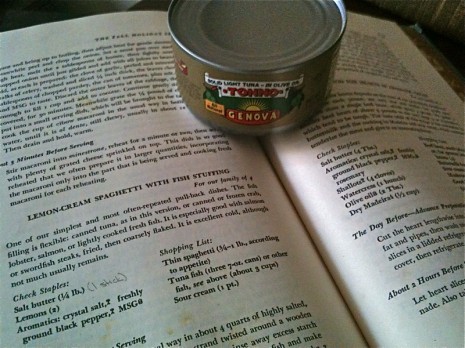SCRATCH SUPPER: TUNA NOODLE SURPRISE
I stared at my haul in consternation. Yesterday evening, when the predicted snowstorm pulled into town right on schedule, I made a provision run and scored two splendid lamb shanks (a long slow braise is just the thing for a snow day), along with a few other goodies. But what I had completely forgotten about was supper that night. I felt like a first-class idiot.
It was getting late, and Sam and I were in dire need of something light yet sustaining. An omelet was out; we’d had eggs for breakfast. The refrigerator yielded a head of romaine and the tender, pale inner leaves from the escarole I’d used in soup over the weekend. There were also lemons and sour cream. Hmm.
I opened the cupboard dedicated to pantry ingredients and took stock.
Why in god’s name were there so many cans of tuna sitting there? Oh, right, that last trip to Costco. Tuna salad? Too lunchy. Tuna melts? Too sandwichy, and I didn’t have it in me to hover around the broiler. Maybe what was called for a blast from the past.
Ah, there it was, a handsome faded blue spine high up on a bookshelf—Feasts For All Seasons*, by Roy Andries de Groot. Virtually unknown today, he cut a pretty wide swath through the culinary world a generation ago, and you would never know from his textured, extremely visual writing that eye injuries he received during the Blitz in London caused him to lose his sight about 20 years later.
I made the point, in a little review I wrote a few years back, that De Groot’s books are what you might call fictionalized, a technique with which I am familiar. I’m from the South, where people’s accounts of what they eat for breakfast are routinely embellished, embroidered upon, and enjoyably refined with each telling, so I can’t get too nitpicky here. Besides, like a good novel, there is something utterly true on every page.
I was introduced to Feasts For All Seasons by my friend and former boss Alfred, who, along with his wife, Bruni, is a marvelous cook. Thanks to them, I discovered that a cookbook could celebrate the seasons (a hackneyed concept today, but news to me then) and span the globe in the process. It is where I discovered Pacific king salmon, Hungarian cold cherry soup, Russian kasha, Middle Eastern tabbouleh, and Spanish moros y christianos.
But leave it to De Groot to saddle one of the easiest, most economical supper dishes in the world with a name that is even impossible to write with a straight face: Lemon-Cream Spaghetti with Fish Stuffing, a.k.a. tuna noodle casserole.
This is not the usual potato-chip-topped amalgam, bound together, circa 1965, with canned cream of mushroom soup and a mother’s love. Nor is it ginned up with gratuitous or intellectually stimulating ingredients by someone who is trying too hard. It’s simply one of those dishes that simultaneously manages to be bright and mellow, spare and rich, and there are plenty of evenings when that—followed by a simple green salad and a couple of satsumas—is all you need.
Oh, right, a quick note on canned tuna: Forget about the all-white stuff packed in water. It has no flavor whatsoever. Buy light tuna packed in olive (not vegetable) oil. The only sustainable brand I like is that made by American Tuna, a company formed by six Pole & Line fishing families in San Diego, California, in 2005. It can be difficult to find, though, so I often end up with Genova brand.
LEMON-CREAM SPAGHETTI WITH FISH STUFFING
Adapted from Feasts For All Seasons by Roy Andries De Groot (Alfred A. Knopf, Inc., 1966)
This recipe serves four. It can easily be halved, but the leftovers are delicious for lunch.
¾ to 1 pound thin spaghetti (spaghettini is ideal; capellini is too thin and overcooks in a nanosecond)
coarse salt and freshly ground pepper
3 cans light tuna packed in olive oil (6 or 7 ounces each), drained
1 stick unsalted butter, plus more for baking dish
1 pint sour cream
the juice of 2 lemons
1. Preheat the oven to 400° F. Cook the pasta in about 4 quarts of rapidly boiling salted water. When it tastes al dente (firmly chewy), drain. Meanwhile, flake or chunk the tuna and melt the butter.
2. In a bowl, stir together the sour cream, lemon juice, and melted butter; season with salt and pepper. Butter a large, shallow baking dish and put about two thirds of the drained pasta in it, lifting it up and spreading it with a fork to make sure it doesn’t pack down. On top, put the fish as a single layer. Cover loosely with the rest of the pasta. Pour the sour cream sauce over the pasta and, with the fork, but without disturbing the layer of fish, lift it slightly here and there to encourage sauce to run down.
3. Set the casserole, uncovered, in the center of the oven and bake just long enough to get everything piping hot and bubbly, usually about 20 minutes. Bring the casserole to the table and plunge the serving spoon straight down, so that each person gets the proper proportion of pasta, fish, and sauce.
*The book is out of print, but copies can be found at abebooks.com and elsewhere online.
Posted: January 12th, 2011 under cookbooks, cooking, culinary history, food, pantry, scratch supper, winter.



Comment from Sally
Time January 26, 2011 at 1:08 pm
Made it for dinner last night, substituted halibut for tuna because that’s what we have in southeast Alaska. Husband loved it. Toddlers loved it. I loved it.